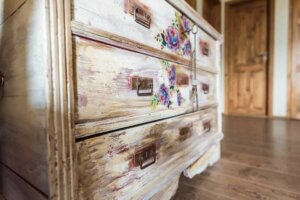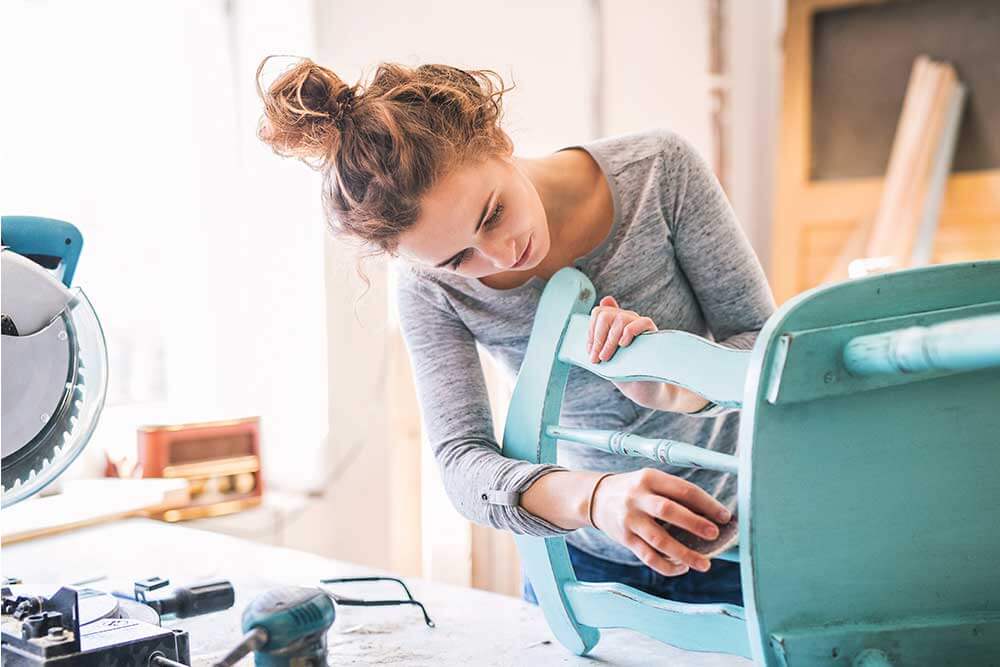Restore Your Furniture With Milk Paint

If you own furniture that you really love, but it requires restoration, milk paint may be the ideal option. With this product, you’ll be able to create a very natural and handmade touch. It’s ideal for giving a new look to furniture, without losing its essence or the tradition behind it.
What is milk paint?

Milk paint has casein as the main component. This is a protein present in milk that’s presented in the form of a soluble complex of calcium and phosphorus. These minerals make it possible for the intestine to absorb it properly. Besides paint, casein can be used in other products such as varnish.
This form of painting is currently trending with the boom of the vintage style. However, it’s also been used for centuries.
It has some great advantages: it’s non-toxic, eco-friendly, biodegradable, and has no odor. It’s ideal for use on wooden furniture and in any of your DIY projects. You can obtain it in powder form, which is great because you can save it and use it when you need it. Of course, you must bear in mind that when you prepare it with water, you must immediately use it, before discarding what you haven’t used.
How is milk paint prepared?
If you’ve already decided to give your old furniture a new lease of life, we’ll explain how to prepare milk paint, so that you can start this project right away.
- Choose a container and add the powder and water.
- Use a hand mixer or whisk the mixture well. Make sure there are no lumps.
- Depending on the opacity you want, you can apply more powder or more water.
- After mixing, let the mixture rest for ten minutes. This way the components of the milk paint will absorb the water. Then, mix again.
- Complete! Your milk paint is ready to use.
In cases where the surface of your wooden furniture is varnished or has wax residues, you should add an adhesive agent that helps the milk paint adhere.
How do you prepare furniture for milk paint?

Depending on the condition of your furniture to restore, you’ll have to prepare the surface to achieve better results.
Clean the surface
The first thing you should do is clean the dust or any dirt away from your furniture. If the surface has varnish or wax residue, try to remove it. For this, you can use sandpaper that, in addition, eliminates imperfections. All this will help your milk paint adhere well.
Apply a primer
It’s up to you whether you do this, but it can be very helpful. The primer coat helps any paint adhere to surfaces. You can apply it after cleaning the furniture, then let it dry.
Apply the milk paint
Milk paint is applied in the same way as any other paint, use a brush for the application. As we mentioned earlier, if the result is too faint, you can try mixing more powder or giving the furniture a second coat. Keep in mind though, that paint becomes thicker and more noticeable in the cracks of the wood.
Do you want to make your own milk paint?
Sure you can make your own milk paint at home! The most surprising news is that you’ll likely have all the ingredients already in the fridge:
- Half a liter of skimmed milk.
- One glass of vinegar.
- 25 grams of powdered plaster.
- A glass of hot water.
Preparation
You should start by placing the half liter of milk on the stove until it boils, then remove it from the heat and add the vinegar. Begin to stir the mixture to separate the protein, then filter the product so that only the casein remains.
Now that you have the end result of the separation, you’re going to mix it with the plaster and water. The final result will be your milk paint.
Milk paint, or chalkboard paint for furniture restoration?

Board paint or chalk paint is also an option to restore furniture and to use on other types of surfaces. It’s also available in powder form and requires water to start painting. It has excellent adhesion and also gives a good vintage finish. The big difference between the two products is that chalk paint offers a matte or powdery effect.
Regarding any doubt surrounding using one or the other, the answer will depend on your tastes. Either way, you’ll enjoy a fresh and traditional result.
Restore your furniture today with milk paint!
As you can see, using milk paint is one of the best options to restore furniture or other types of surfaces that need a refresh. You can buy it ready to prepare at home or make it yourself to complete your DIY experience. Without a doubt, after this restoration, the furniture that you love so much will have even more sentimental value.
If you own furniture that you really love, but it requires restoration, milk paint may be the ideal option. With this product, you’ll be able to create a very natural and handmade touch. It’s ideal for giving a new look to furniture, without losing its essence or the tradition behind it.
What is milk paint?

Milk paint has casein as the main component. This is a protein present in milk that’s presented in the form of a soluble complex of calcium and phosphorus. These minerals make it possible for the intestine to absorb it properly. Besides paint, casein can be used in other products such as varnish.
This form of painting is currently trending with the boom of the vintage style. However, it’s also been used for centuries.
It has some great advantages: it’s non-toxic, eco-friendly, biodegradable, and has no odor. It’s ideal for use on wooden furniture and in any of your DIY projects. You can obtain it in powder form, which is great because you can save it and use it when you need it. Of course, you must bear in mind that when you prepare it with water, you must immediately use it, before discarding what you haven’t used.
How is milk paint prepared?
If you’ve already decided to give your old furniture a new lease of life, we’ll explain how to prepare milk paint, so that you can start this project right away.
- Choose a container and add the powder and water.
- Use a hand mixer or whisk the mixture well. Make sure there are no lumps.
- Depending on the opacity you want, you can apply more powder or more water.
- After mixing, let the mixture rest for ten minutes. This way the components of the milk paint will absorb the water. Then, mix again.
- Complete! Your milk paint is ready to use.
In cases where the surface of your wooden furniture is varnished or has wax residues, you should add an adhesive agent that helps the milk paint adhere.
How do you prepare furniture for milk paint?

Depending on the condition of your furniture to restore, you’ll have to prepare the surface to achieve better results.
Clean the surface
The first thing you should do is clean the dust or any dirt away from your furniture. If the surface has varnish or wax residue, try to remove it. For this, you can use sandpaper that, in addition, eliminates imperfections. All this will help your milk paint adhere well.
Apply a primer
It’s up to you whether you do this, but it can be very helpful. The primer coat helps any paint adhere to surfaces. You can apply it after cleaning the furniture, then let it dry.
Apply the milk paint
Milk paint is applied in the same way as any other paint, use a brush for the application. As we mentioned earlier, if the result is too faint, you can try mixing more powder or giving the furniture a second coat. Keep in mind though, that paint becomes thicker and more noticeable in the cracks of the wood.
Do you want to make your own milk paint?
Sure you can make your own milk paint at home! The most surprising news is that you’ll likely have all the ingredients already in the fridge:
- Half a liter of skimmed milk.
- One glass of vinegar.
- 25 grams of powdered plaster.
- A glass of hot water.
Preparation
You should start by placing the half liter of milk on the stove until it boils, then remove it from the heat and add the vinegar. Begin to stir the mixture to separate the protein, then filter the product so that only the casein remains.
Now that you have the end result of the separation, you’re going to mix it with the plaster and water. The final result will be your milk paint.
Milk paint, or chalkboard paint for furniture restoration?

Board paint or chalk paint is also an option to restore furniture and to use on other types of surfaces. It’s also available in powder form and requires water to start painting. It has excellent adhesion and also gives a good vintage finish. The big difference between the two products is that chalk paint offers a matte or powdery effect.
Regarding any doubt surrounding using one or the other, the answer will depend on your tastes. Either way, you’ll enjoy a fresh and traditional result.
Restore your furniture today with milk paint!
As you can see, using milk paint is one of the best options to restore furniture or other types of surfaces that need a refresh. You can buy it ready to prepare at home or make it yourself to complete your DIY experience. Without a doubt, after this restoration, the furniture that you love so much will have even more sentimental value.
All cited sources were thoroughly reviewed by our team to ensure their quality, reliability, currency, and validity. The bibliography of this article was considered reliable and of academic or scientific accuracy.
- Lanzarini, Alberto. (1907). La Caseína : contribución a su estudio químico e industrial.. Facultad de Ciencias Exactas y Naturales. Universidad de Buenos Aires. http://digital.bl.fcen.uba.ar/Download/Tesis/Tesis_0052_Lanzarini.pdf







